The Medieval Project (TMP) is a research project examining the visual culture and thematic representation of the monstrous and demonic in medieval art, architecture, wall paintings, and illuminated manuscripts, with a particular emphasis on depictions of the Apocalypse, Last Judgment, and Doom. While a formal MA in Medieval Studies remains a future aspiration (one I hope to realize in the next few years!), TMP provides a valuable platform for publishing my ongoing independent research and engaging with medieval art, history, and culture through courses, lectures, and travel. My fascination with the monstrous began with a school trip to Europe at 16. Standing before Notre Dame Cathedral, I was captivated by its gothic beauty and the grotesques and gargoyles perched above—an experience that sparked a lifelong passion for medieval art and architecture. Coming from NYC, this was a completely new world, and I knew I had to explore it further. My approach to this research emphasizes engaging storytelling, recognizing that history comes alive when it resonates with audiences. While I strive to balance scholarly accuracy and original insights, TMP also adopts a casual and accessible style, interweaving elements of pop culture, such as memes and GIFs, to connect with a wider audience.
Don't wanna be here? Send us removal request.
Text
Mandrakes - Medieval Pareidolia
I see people. Mandrake people.

Side by side comparison: A real mandrake root and a personified mandrake illustration. 📸 Left, a "live mandragora," Il Crogiuolo. Right, an illustrated mandragore from De materia medica, MS M.652 f. 104v, ca. 950.
You know when you can't help but see a face in an inanimate object like that empty electrical plug outlet looking right at you or empty coat hooks waiting for a jacket or the human figures found in landscapes or clouds? You are not crazy. This is experience is called human pareidolia. It is a term to describe when our brains over-attribute the pattern of the human body and/or mind in unrelated things. It is closely related to anthropomorphism, which is just a big word for humans giving non-human things human traits, emotions and abilities. Think the personification of all the seven deadly sins (see last post), Sonic the Hedgehog, and the Energizer bunny (I'm dating myself here). Think the mandrake.

The mandrake, mandragora in Latin is a root of plant whose shape resembles the form of a human. I opened this post with side by side comparison. It is clear to see how a person would "see" a human body in its roots. You can see in the illustration of the mandrake in the Mappa Mundi above but also in the side by side comparison image I opened this post with - on the right how a person may "see" in its root the form of a human.

Medieval mandrake (amongst other things) 📸 My own. From my souvenir poster of the Hereford Mappa Mundi (the real map is dated ca. AD 1300)
The Mandrake
It has long history and only a portion of it is covered here. Much of the time the mandrake has be associated with magic due of its roots' properties.
The following pharmacological, anthropomorphic/pareidolia properties and mythological attributes surely secured its magical destiny and it's notoriety today:
root shape resembles a human figure
root and leaves are poisonous
root is a hallucinogenic and a narcotic
root is poisonous
when harvested it screams and kills anyone who hears it (medieval folklore addition)
used in magical potions and witches’ flying ointments.

History and Lore of Antiquity
The mandrake was mentioned in two pioneering works on botany or what was called herbal medicine (the study of crude drugs derived from medicinal plants) back in antiquity. In the 4th century BCE, Theophrastus, a Greek philosopher and naturalist, often considered the father of botany, wrote a ritual about how to harvest the mandragora in Enquiry into Plants or Historia Plantarum. It included using a sword to draw three circles around the root and cut it out facing West. To get additional pieces of the root, he added one must continuously speak lewdly about sex while dancing around it.

In the 1st century, Dioscorides, a Greek physician, pharmacologist, botanist, and author of De materia medica (the go to pharmacological manual across Europe and the Middle East for over 1,500 years), lists the uses of the mandrake as a narcotic, an anesthetic for surgery and a substance to induce abortion. He also claims it is an ingredient in love potions.
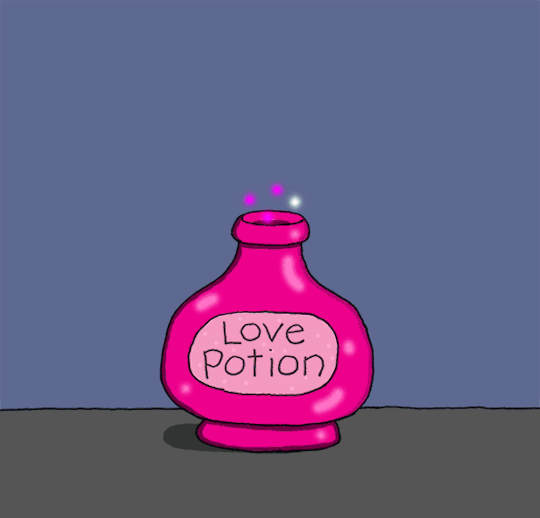
Check out the 6th century and 15th century illuminations found in De materia medica where a woman is presenting a mandrake to Dioscorides. Note the mandrake's human form and the dog tethered to the mandrake. I'll explain more about that shortly.
It seems that either the mandrake was so crucial to medicine at time or the De materia medica illustrators thought it was an interesting subject to depict.


Left, Pedanius Dioscorides, The Viennese Dioscorides: Codex medicus Graecus 1, Austrian National Library, Graz, 6th century, fol. 4v. Right, Vatican City, BAV Chig. F. VII. 159, folio 234v
Also in the first century AD, Flavius Josephus, the Roman-Jewish military leader and historian, writes about the mandrake. He gave tips on the difficult task of uprooting the dangerous mandrake (used in exorcism!). How hard could it have been?
Well, according to Josephus, the mandrake would move away from the harvester and grab their hand. And, while he says the mandrake can be stopped if you had women’s urine or menstrual blood to pour on it… You can’t make this stuff up!, he proposed the following method below, in case you were running low on women’s urine or menstrual blood:
“A furrow must be dug around the root until its lower part is exposed, then a dog is tied to it, after which the person tying the dog must get away. The dog then endeavours to follow him, and so easily pulls up the root, but dies suddenly instead of his master. After this, the root can be handled without fear.”
Medieval Lore
Properties of the mandrake are unique for several reasons but I think #5 - it is screams when harvested and kills anyone who hears it - is the best piece of lore. We have medieval people to thank for that.

Death by mandrake without the use of a dog
Having taken Josephus' words to heart, medieval folklore took the use of a dog as a key component to harvesting the root without one dying and they added the screaming bit when the mandrake is pulled from the ground. It was said that mandrake grew from places where criminals had "spilled their fluids."
Medieval Mandrake Illuminations
How to Harvest a Mandrake
In the following manuscripts, you can see these dogs in action. If you refer back now to the illuminations of the De materia medica with Dioscorides and the mandrake, notice the dead dog tethered to the mandrake.
12th century


Left, Mandrake. BL Sloane MS 1975, fol. 49r., ca. 1175–1200. Right, Mandrake. Cotton MS Vitellius C III (BL), ca. 12th century, f. 57v.
13th century


Left, Mandrake., Ms. Français 14969 (BnF), ca. 13th century, f. 61v., Right, Mandrake., Antonius Musa, Herbal, MS.573 (Wellcome), ca. 1225–1275, f. 35v.

Medizinische Sammelhandschrift, HAN Cod. 93 (Österreich Nationalbibliothek), ca. 1200, f. 117v.
14th and 15th century




Top left, Mandrake (Mandragora officinarum) from Tacuinum Sanitatis manuscript Cod. Vindob. ser. nov. 2644 (Österreichische Nationalbibliothek), ca. 1390.
Top right, Gr. 3632 (Biblioteca Universitaria di Bologna), ca. 15th century, f. 379r.
Bottom left, Johannes Hartlieb, Kräuterbuch, in Cod. Pal. germ. 311 (Universitätsbibliothek Heidelberg), ca. 1455–1460, f. 289v
Bottom right, Tractatus de Herbis, Sloane MS 4016 (BL), ca. 1440, f. 56v. This is the only one I found from this period without a dog😳
21st century
Harry Potter and the Chamber of Secrets

The biggest thanks for bringing the mandrake into pop culture goes to JK Rowling. We learned in Hebrology class that the Mandrake Draught was a powerful antidote for Basilisk petrification and the movie sure did emphasize the loudness of the mandrake scream.
Neither book or the movie spoke at all about the mandrake being a key ingredient in magical potions and witches’ flying ointments. But we'll let it slide.
Delicious in Dungeon
Originally a Japanese manga series and last year turned into a animated series, one episode features the mandrake. For those that don't know the story, basically a group of adventurers lost one of their own after a dragon ate her, they now go through a dungeon to rescue her but need to eat the monsters they find along the way.

Mandrake and basilisk omelette is served. Apparently mandrake heads are the best part. Episode 2 of the animated series.
Little Witch Academia
Another Japan anime series but this one involves a witch training school for young girls. Here the mandrake scream can hurt or kill non-magical humans and animals. The older the mandrake the more fatal the scream. Younger ones can cause unconsciousness.

Akko attacked by a mandrake 📸 by Black Soulstone posted in the Little Witch Academia Fandom Wiki
Want more mandrake?

I found these shops selling mandrake-y things , I do not make any commissions from these, just thought they were cool.
Lego
Interactive Plush
Planter tutorial
Actual seeds and plants
References and for more info
Mandrake, mandrake
The Biology and Evolution of the Three Psychological Tendencies to Anthropomorphize Biology and Evolution
Mandrakes are real 👇
youtube
This post is dedicated to my eldest son. We were introduced to mandrakes while reading Harry Potter together. Shai, there are few things in this world that are as special to me as time spent with you❤️
0 notes
Text
Hell on Earth! Movie edition: The Substance has it all - Body Horror, Sin and Medieval Hell
Spoilers!
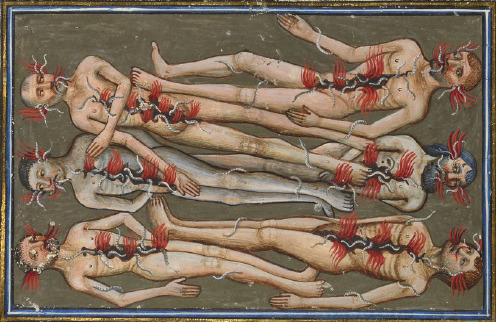

Left, Worms and fire bursting out of the damned. Livre de la Vigne nostre Seigneur, Oxford, Bodleian Library, MS. Douce 134, fol. 91v. Right, Elizabeth Sparkles with a sewn-up back. The Substance, 2024. Mubi.
Body horror
According to Wikipedia: "Body horror, biological horror, organic horror or visceral horror is horror fiction in which the horror is principally derived from the unnatural graphic transformation, degeneration or destruction of the physical body. Such works may deal with decay, disease, deformity, parasitism, mutation or mutilation. Other types of body horror include unnatural movements or the anatomically incorrect placement of limbs to create "monsters" from human body parts."

Body horror comes down to our visceral reaction of disgust when seeing the human body grossly altered from its natural state. The response depends on our own individual thresholds for how grotesque or horrifying we may consider the resulting transformation. And we have a word for this post-transformation: Monster.
The Substance delivers an extraordinary level of repulsion and we have no choice but to be sickened by the sights of it.
And, it makes sense. The Substance, as in the actual substance that is used in the film of the same name, and the body horror that is created from misusing it, goes against nature and the natural order of things.

The Substance at Mubi.com
Hell

Medieval Christian Hell is the epitome of an unnatural, perverse hierarchy. In Hell, the damned are reduced to the bottom of the pecking order and are horrifically tortured by Satan and lesser demons.
These Hellish creatures are depicted using a specific conventional format that effectively uses human bodies as the control, the natural form (you know, made in God's image, and all that) and conceives demon bodies as the antithesis of them.
Before we get to the scenes that highlight The Substance's body horror, I want to explore the roots of today's body horror in Medieval Hell's demonic creatures through the Livre de la Vigne nostre Seigneur (The Vineyard of Our Saviour). It is a 15th-century French/Latin sermon that focuses on the end of the world and features a ton of illustrations of Satan and demons. If this is not considered medieval body horror, I'm not sure what is.
Note: I will use the words for Hell's head honcho - Satan/Lucifer/The Devil interchangeably as well Satan's minions - lesser demons/devils torturing the damned.
Demonic Bodies

Lucifer front and center with lesser demons surrounding him being judged by Christ in Majesty above (not shown) Livre de la Vigne nostre Seigneur, Oxford, Bodleian Library, MS. Douce 134, fol. 67v.
The Devil, for all his hair, horns, fangs, claws, talons, another eye for a bellybutton, smaller devil head joints and huge devil head crotch with its tongue aptly placed, is essentially a white-labeled, infernal version of us.
The foundational form of a human is clear: a head with two ears, two eyes, a nose with two nostrils, a mouth with teeth, a torso, two arms, two hands, two legs, which they stand on, and two feet.
We recognize this form enough to relate to it but it's been skinned with enough repulsive evil elements to shock and horrify us (body horror). Lucifer in particular is frankensteined together. Small devil heads connect his torso to his upper arms, two more devil heads connect the upper arms to his lower arms and then two more heads connect his thighs to his calves that end in talons.
Lesser devils are also hybrid human/animal forms and follow the same blueprint of personifying evil. Starting with a human's upright posture, various animalistic traits are then swapped for human body parts to keep things interesting, like ear shape, eye color, skin type and color. There are also additional evil animalistic characteristics like hairiness factor, horns, tails, teeth and claws. Lesser demons often get only one head and maybe another in the midsection.
In the next illumination, Satan is shown with a crown of six heads on his own head, referencing the text of Revelation 12:3 where the great dragon is described as having seven heads and ten horns, and Revelation 12:9, where the great dragon, aka that old serpent, who is called the devil and Satan was cast out of Heaven. The amount of heads is a Satanic status symbol.
Here Satan spews fire from his ears and his minions breath fire out of their mouths. They all grasp torturing hooks. Their animalistic features are contained variations within the upright bipedal stance. Artists plug in an animal face for a human face, animal feet for human feet, scales or fur for human skin.
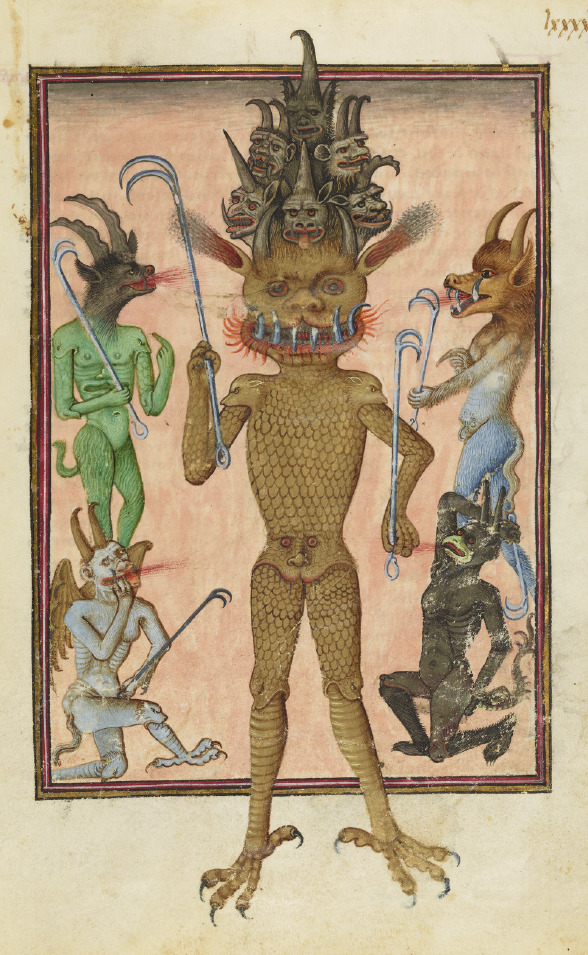
Lucifer with a crown of six devil heads and an entourage of devils revering him. Livre de la Vigne nostre Seigneur, Oxford, Bodleian Library, MS. Douce 134, fol. 98r.
Demonic bodies torturing Damned "bodies"

Devils holding down their prey. Livre de la Vigne nostre Seigneur, Oxford, Bodleian Library, MS. Douce 134, fol. 100r.
Within illustrations of demons torturing the damned, the plug and play "build a demon" is even more apparent.
Above in folio 100r, devils are biting and scratching at the damned. In the upper right corner, one winged devil bites a damned man's back. They both bend over in the same position. The man's naked, white, hairless (but for his head) body is contrasted against the devil's body covered in fur, with its horned boar-head, wings, tail and claws.
The man standing in the center of the scene with his arms crossed in front of his groin is being bit on the shoulder by a devil behind him who has a devil's face in its groin. They both stand in a similar fashion but the contrast between the man covering himself while the demon face groin emphasizes the demons vulgarity. Both bodies feature the same ribcage detailing on the torso but the man's body is virtually hairless and naked and the devil is covered in hair. In addition to his ape like face his adorns horns
Below in folio 100r, four demons wield weapons in one hand and grab each of the damned with other. In every demons' depiction, their form has the same human musculature, same skeletal structure and the resemblance in their forms to humans ever more evident.
Devil forms must keep the human structure so they can physically carry out torture AND be scary enough, yet recognizable, to enact a medieval equivalent of body horror.
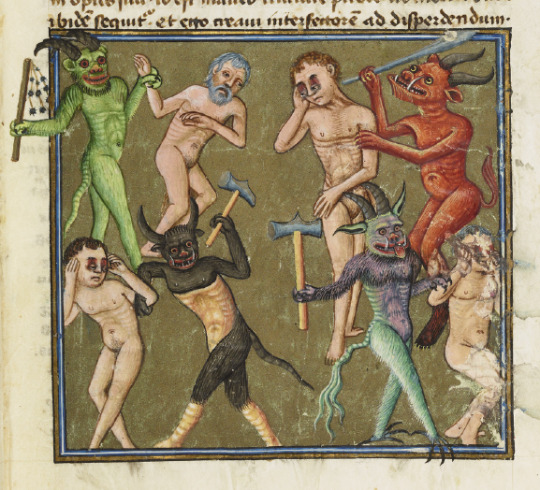
Weapon of Choice. Devils attack the damned. Livre de la Vigne nostre Seigneur, Oxford, Bodleian Library, MS. Douce 134, 101r.
The Seven Deadly Sins and Medieval Hell
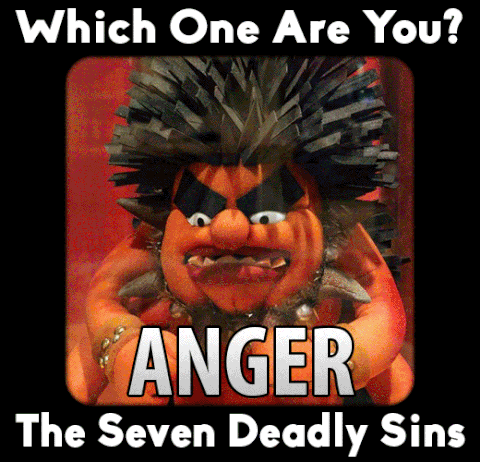
Medieval Christians believed in God's divine judgment. The damned in Hell would have committed sin(s) in life and God cast them there. The standard list of sins are pride, greed, wrath, envy, lust, gluttony, and sloth. In Hell, every sin had an appropriate punishment and demons would torture the damned based on which sins they committed.
The Substance, the Seven Deadly Sins and Body Horror Spoilers, for real

Pride
Elizabeth, a celebrity, who at 50, after many years in the spotlight and successful because of her body, finds out her long career is over. She a TV fitness personality that can't go far without seeing a billboard-sized picture of herself. She is surrounded by enormous, full body images of her younger self at work (take that long hallway) and the only image in her scarce hi-rise is another enormous, younger, full-body billboard. It seems that Elizabeth was quite satisfied by how she looked before she overhears her boss tell someone on the phone she will be replaced for being old.
Medieval Christianity, often considered pride the worst of all the seven deadly sins and from which all others take root. In many collective depictions of the sins, artists personify Pride as a woman looking at herself in a mirror. See her all the way at the bottom, at the root of the Tree of Vices. All other vices stem from Pride.

Tree of Vices, Stiftsbibliothek Kremsmünster Codex Cremifanensis 243, fol. 3r. Der Buchkünstler ist unbekannt, Public domain, via Wikimedia Commons

Lust
Elizabeth's desperate desire to be young and beautiful again, makes her decide to use a blackmarket substance that creates another, better, younger version of herself. It is from this premise that we know only something horrific can and will happen.. cause then, no movie.
It's also an interesting spin on lust. Elizabeth is shown as a loner, she isn't yearning to be with someone. She covets her own youth.
If we think of this "magic" substance promising Elizabeth the creation of a better version of herself, in terms of Christianity, this concept goes against nature and God (they are one and the same). This can only mean it's the work of Satan, Antichrist or false prophets who claim to be Christ through miracles but are not. For someone like Elizabeth, this proposition is the ultimate test of humility. It is an ingenious setup for diabolical forces to counter society's veneration of women's youth and beauty with monstrous body horror.
Body Horror: The Birthing of Sue
We cannot make another version of ourselves. We can change ourselves, augment ourselves, maybe one day even clone ourselves but we cannot physically bore another fully-formed human version of ourselves. The only other human that can be physically born through a body of another human, is a different person and not you.

When Elizabeth does bore Sue, she does so through a most unnatural, hellish way. She, like the damned in hell, begins this process naked, as she shoots the activator serum into her body. After writhing on the floor, we see a mass appear that throbs along her back. We see her green eye create another pupil. The mass grows and the second pupil disappears as Elizabeth's back splits open to reveal a whiter, fresh skin underneath. A new blue eye appears next to the green eye in her eye socket, that gets pushes out by the green one.
Then there's a transition scene that involves the transition itself, moving lights and sounds, giving the audience a feeling of moving through time. It ends with a fire that begins to take shape into a heart. Then Sue is "born."
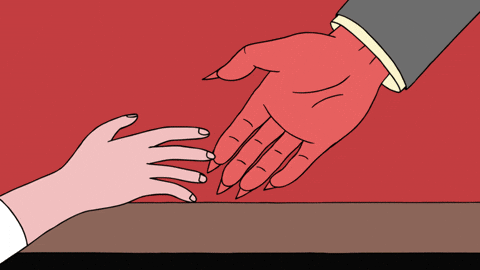
Is this horrifying experience one of the prices you pay for making a deal with the Devil?
Spine stuff. Behind the scenes @trythesubstance on Instagram
Seeing Elizabeth go through the transformation was uncomfortable to say the least. The most gruesome part, at least for me, when her back split open, was when Sue sewed up Elizabeth's gash. The sewing kit itself was so primitive and raw, it made me think of pre-modern suturing methods and also that ungodly scar Elizabeth must wear as a mark of her sins, like that of a witch's mark. Sue is born as far as we can tell with just a trio of birthmarks on her ribs.
Sue sewing Elizabeth's back up suture by suture with a scissor and a shoelace was the first thing she did to take care of her "other self." Elizabeth was told from the beginning that in using the Substance, she and her better version should remember that, "You are one."

We see the first week go by where Sue auditions for Elizabeth's old job and gets it. She is told how perfect she is. Then another transitory element with what looks like a fire spreading that turns into a dragon. Sue switches with Elizabeth.
Elizabeth wakes up and feels her back for the first time. She touches Sue. She showers, she makes eggs. She goes to her old job to collect her things. She showers. She's back home. She turns on the TV and flips through the channel the rest of the day and night and then gets notice of a refill kit. Elizabeth has to go back to this dingy lair to access the box. She's home again and is again watching TV all night.
Sloth

The next scene is Sue doing yoga in her underwear (TV still on) doing a Coke commercial. She sees Elizabeth's butt print in the chair. What we see of Elizabeth is what is shown in Sue's scenes when it's her "turn." At first we don't know how bad it is for Elizabeth but we get a hint that she is becoming a recluse, eating and watching TV all the time.
This sin should be thought of in terms of not just being lazy but neglecting oneself, one's responsibilities. Elizabeth becomes a recluse, eating and watching TV only to do it again the next day.
Greed

Sadly, before we know it (but did know it would happen) the required balance of keeping Elizabeth and Sue alternating time between themselves is destroyed. While Elizabeth is clearly jealous of Sue's body, staring at her on the TV, and the opportunities available to her because of it, she appreciated it enough to keep the balance. Sue wholeheartedly relishing in her youth and beauty and the life it gave her, decides to take time from Elizabeth.
The consequence of this is that Elizabeth begins to transform. The first sign of the imbalance is Elizabeth's green, witchy, corroded finger, which is irreversible. The only option is for both of them to respect the balance or quit and die.
The witch finger struck me as a perfect place to start the journey of Body Horror. Witches are typically known to be old, haggard and green women who ride on brooms, practice magic and have sex with the Devil. Medieval Christianity had a lot do with do with making women who did not conform to society into evil witches. This one witchy finger is a nod to Elizabeth's evil status. It is a mark of her connection to the demonic. Just like her sewn up spine, her body continues to reflect this kind of Devil's Pact she has made to be beautiful.
Envy

There is a scene with Elizabeth vacuuming the living room with her witch finger, Sue's billboard is in her face and Sue's Pump it Up video comes on the TV. Elizabeth stops and sits to ogle every bit of Sue's perfect body, but when Sue blows a kiss at the audience like Elizabeth once did, she is full of rage. Elizabeth showers again and goes to get another refill kit. She gets increasingly paranoid. She gets home and calls that former classmate who thinks she's the most beautiful girl in the world. She starts getting ready for their date and quickly looks in on Sue's body, taking in her luscious lips and perky breasts, and she puts on more makeup. Then, as she is finally leaving the house, she forgets she didn't take her keys and walks back to the living room and sees Sue's billboard in her face. She focuses on Sue's supple cleavage and she puts on a scarf to mask her aged skin. Elizabeth's inner demons cause her to spiral into a vortex of self-loathing. She never leaves the house to go on the date and starts to eat instead.

We jump to Sue and, as she films another video, a mass appears on her butt. Finally the imbalance is affecting Sue's body. The crew, who only thought they caught a glimpse of something, stop taping and start a massive investigation to pick her perfect body apart. Sue is called into her boss's office, scared her world is about to fall apart and, in the end, the boss doesn't talk to her about any lump, but offers her the job of hosting the network's New Year's Eve show. Sue gets home and takes more time from Elizabeth.
Wrath

One night while watching TV, Elizabeth wants to get up but her left leg won't move. She painfully cracks it into place and manages to get over to the unopened gift her old boss gave her. It's full of all kinds of rich French recipes. At that moment, Sue appears on the TV and Elizabeth starts furiously cooking while watching Sue being interviewed. She angrily cooks a feast and, as Sue condescendingly talks about Elizabeth being old, Elizabeth takes her anger out on the food. When Sue is asked what her beauty secret is, Elizabeth screams at the TV wanting her to divulge that she, Elizabeth is the secret and flashes her naked body from under her robe. Elizabeth starts talking to herself in the mirror and then takes a shower. This shower has the most dramatic effect - Elizabeth was laying at the bottom of a well or at the bottom of a deep hole. I think all the shower symbolism relates to Elizabeth attempting to cleanse herself and wash away her sins.
Sue wakes up to a house littered with wall to wall food and guts and newspapers plastered on the walls. In the horror of what she has seen, Sue is furious and she takes and takes and takes and robs Elizabeth's body of almost all it has.

Three months pass and the New Year's show is tomorrow.
Sue starts to feel ill because she ran out of Stabilizer fluid - the fluid she has been stealing from Elizabeth. The only way to get more is to switch with Elizabeth. Sue is writhing in pain, she crawls to the bathroom and switches. Then we see Elizabeth's hundred year old-looking gnarled feet, her hundred years old-looking legs, her bruised back and hairless head, her hundred years old-sagging butt. In three months she has a hunched-back corpse of a body.

Elizabeth calls the Substance hotline and says she wants to stop but she must pick up the Termination serum. Her corpse body drags her old living room billboard back to its spot. She has new-found herculean strength, almost like that burst of energy many dying people get a couple of days before they actually die. She runs like a bat out of hell to get the serum that will end it all. Once back, she drags Sue into the living room, in front of her billboard, she is ready to stab Sue and end it all.
At the last second, she stops and thinks about people loving her (as Sue) and she starts smiling. She tells unconscious/dead Sue "I hate myself," then tells her she has to get ready and its their big night and she loves her so much. Elizabeth gives Sue life again with an infusion of her blood. Sue revived sees the Termination syringe and becomes full of rage. She beats Elizabeth into a bloody mess, killing her and then realizes it's time for the New Year's show.

The sin of wrath is defined by hateful rage possibly in seeking vengeance with desire to inflict extreme harm or punishment or the desire to kill.
Body Horror: The Creation of Monstro Elisasue
Gluttony

Sue's over-indulgence in taking from Elizabeth finally comes back to haunt her. On the big night, she starts to physically fall apart. While coughing, she loses teeth and her fingernail falls off.
In her desperation to try and eek out any remaining chance of making it to and through the New Year's Eve show, she bolts off the set and runs home. She reaches for the Activator serum, which can only be used once! But in her hysteria, Sue uses it anyway and hopes for the best!

Before our eyes, she falls to the floor. Her eye socket instantaneously multiples with several eyes, her back splits open. She transforms into a grotesque monster. Kudos to the design and effects team. You can peep part of Elisasue here on Wikipedia. Again, that transitory lights and sound and fire that forms a heart.
What you don't see in this Wikipedia is the entirety of Eliasue's deformed form, an amalgamation of additional skin and body parts all of the place, like mouths with teeth on her chest and eyes and ears in random places. Elisabeth's head stretches out of their back, amongst other horrifying things.
The sin of gluttony is demonstrated throughout the movie, but Sue's excessive desire to increasingly "eat" more than her share at all costs, leads to the creation of the biggest body horror yet.

Sue's punishment is Elisasue's body. Sue once inhabited a youthful, beautiful body that everyone wanted to have or to touch, everyone loved her and wanted to watch her as much as possible. Now she is the horrifying monster, something that bares resemblance to a human but has been transformed enough to make us all fear and abhor her.
Like the damned in Medieval Hell, she will be robbed of the thing she coveted most and for that she is made hideous. Elisasue will be hated and she will be destroyed. In this living hell, the Substance exploited her inner demons. She doesn't need the Devil and demons to torture her, she tortured herself.
And then something entirely unexpected happens: Elisasue dresses herself up, puts earrings on, flatirons the last remaining strands of her hair. She stops to smash the billboard of Elizabeth in the living room, cuts the face out and glues it to her face with the addition of red lipstick. Eliasue is confident in this demonic form with her Elizabeth mask to return for her big night and big finale.
With her glued on Elizabeth mask no one notices anything wrong with her body. Through the eyes she cut into the mask, we see how she sees people telling her, "So beautiful," "We love you." Does the Satanic substance also trick people to see what they want to see?

The body horror climax of the film plays itself out after Eliasue stands on stage. The audience watches her desensitized for some time but eventually her Elizabeth mask off and the audience just stares. Elisasue growls and grunts and out of her head a breast with an embilicord falls to the fall. Suddenly screams "The Monster!" "and "Shoot the Monster" and "It's a Freak!" Elisasue says into the microphone, "No, don't be scared. It's still me." Elizabeth's face through ripped tulle says "It's me."
Then Elisasue gets pushed around. They scream "You freak," "You Monster." She falls to the ground, a spotlight on her. She gets up and someone hacked her head off. It regenerates into several heads and bites herself, spraying the audience. Just like Lucifer and the lesser demons from Livre de la Vigne nostre Seigneur, fol. 98r!
Elisasue flees the studio. She falls and splatters all over the sidewalk.
Body Horror: The No Body Elizabeth
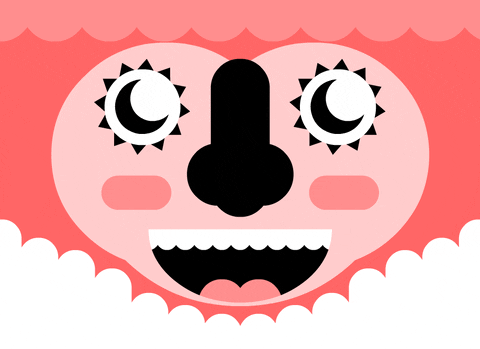
Elizabeth's face grunts and strains with all its might to rip itself free from what is left from the mutilated Elisasue. Like an octopus using its tentacles to walk across land, she slithers along in agony. Her face contorting in pain, yet she continues until she reaches, of all places, the Elizabeth Sparkles star, her star, on the Hollywood Walk of Fame.
When Elizabeth reaches the star's center, she can finally rest. She sighs and stares up at three palm trees. Then sparkles fall from the sky. A spotlight turns on and a reverberating sound of triumph and applauds. She is smiling, she is ecstatic.
She replays the time before the show when she wore the Elizabeth mask and people were telling her, "So beautiful," "We love you." The very opposite of what happened when she was part of Elisasue. She envisions her cherished view of herself, limited to her face, before this whole thing started. The spotlight vanishes and she melts away into a pool of blood.
Redemption

Elizabeth Sparkle was never free until she was without a body and the societal demands a body places on a woman.
In the last scene, without her body, she reached a state of true happiness. Almost like she reached Heaven and had a beatific vision but there was something sinister about it. She was free from the demands a body gives a woman.
It was as if her whole life she was in Hell. Or maybe Purgatory. She had to go through a number of tests and horrors to ultimately understand that the root of all evil was never The Substance but the glorification of a woman's youthful body.
Or maybe the Substance was just the Devil (society), tempting her, poisoning her, and all us women who reach 40 and look at ourselves in the mirror and are not satisfied with what time inevitably does. We decide to use fillers, obsessively dye our gray hair, think about what we can lift or tuck. Maybe it was an exercise to see how far she, (I mean us), would go to look young.
Sin is believed to be an act against God. It is an evil act that violates God and his laws. The retribution for sin is torture for the damned by demons. In Elizabeth's case, the demons were her making: her new perfect, younger, version of herself versus her and her actual self with her own lack of self worth and self esteem. When she did not keep the seven day balance (either as Elizabeth or Sue) and stole from herself, she effectively tortured herself with body horror that got progressively worse.
In Medieval Hell, the tortures inflicted on the damned were based on the sins the person committed in life. This is due to the medieval belief in divine judgment where every sin had an appropriate punishment. So while Elizabeth committed all seven sins, her first was pride and, as I mentioned earlier, pride was looked at as sort of the gateway drug-sin to other sins. Her pride purposely shown so early on and so overtly in her excessive use of "mirrors," aka gigantic billboards of herself from young to present day hung at work and in her home, showed us where she found self worth, which was indeed her downfall and also her punishment. Every punishment for stealing time showed itself as varying degrees of body horror. For Elizabeth, The Substance unleashed her perfect Hell.
Is it ironic how Elizabeth finally finds salvation without a body? She couldn't be happy with her 50 year old body. She couldn't be happy with a younger version of herself half the time and her 50 year old self the other half. She had to completely lose her body to be happy.
Salvation is thought to occur by God's grace or by atonement of one's sins.
Did Elizabeth redeem herself in the end? Did she atone for her sins by finding beauty in Elisasue, in herself, when she confidently left the house to do the New Year's Eve show? Did she atone for her sins when she proclaimed on stage in front of an audience and millions of viewers that it was her all along? Was it by God's grace that she got to experience a few minutes in a state of happiness without a body that caged her? Or was it that she didn't know what she had until it was gone.
A final thought: Vague Transitions
I posit that these animated transition devices which come at critical points of transformation (Elisabeth to Sue, Sue to Elisabeth, and then Elisasue) was intended to represent the role of evil and the power of the Devil. Fire, itself being a reference to Hell, is shown taking the form of a heart twice and a dragon once.
The heart formations occurred when Sue was created and again when Elisasue was created. Both times Elizabeth and Sue are tied to one another by unnatural, demonic acts of creation. The dragon formation that appears on the back Sue's robe, is a clear reference to Revelation and Satan. When wearing this robe, Sue is filled with a menacing air. The intoxication of power she feels is exhilarating. Standing over Elizabeth's stitched body on the bathroom floor, it is as if, at that moment, she decides the balance will never work. While Elizabeth is told she is the "matrix," Sue knows that it is really her who is in control. She will disrupt the hierarchy just like the Devil's spawn she is.
References
The Substance
Body Horror
Bodleian Library MS. Douce 134
End of Time in the Middle Ages, The Vineyard of Our Saviour Bodleian MS. Douce 134
Revelation 12:3-9
The Seven Deadly Sins: Pride, Lust, Sloth, Greed, Envy, Wrath, Gluttony
Coursework from Death and Devotion: The Art of Death across the Middle Ages, Oxford Continuing Education
#hell#seven deadly sins#medieval christianity#the substance#body horror#medieval hell#wrath#gluttony#pride#greed#sloth#envy#lust#revelation#medieval manuscripts#medieval
3 notes
·
View notes
Text
Take me to Church: Jubilee 2025 and pilgrim cards ✝️

Be a real pilgrim
I wasn’t planning on going to Rome next year, but now there's a good chance I will! How could I pass up a holy year!

Here's the details:
From December 23 of this year through next 2025 you can go to Rome and be a pilgrim.
Beginning on the night of the previous Christmas Eve with the opening of the holy doors of Rome's four main basilica's starting from St. Peter's in the Vatican (obvs). The Pope arrives and says this in Latin: "This is the door of the Lord, open to me the door of righteousness," then pushes open the doors, steps into the threshold, prays and then voila!, the holy year has begun.

Over the next following days Pope Francis will then show up and do the same shpiel at San Giovanni in Laterano, Santa Maria Maggiore and St Paul Outside the Walls. Holy Doors are open all the way until Jan 6.
Get your free digital pass - with your name on it(!) in order to book Jubilee events and book your pilgrimage dates to the Holy Door!
Pilgrimage routes
There's more - there’s 8 pilgrimage routes to conquer, if you wish to experience the whole shebang.
1 note
·
View note
Text
Textile Time: House of Dragons Season Two Opening Credits

It took nearly 2 years for House of Dragons to come back to us and yes, this post is a bit late with only one episode left of the season 😬 but I’m trying to embrace the "it's better late than never," and I'm working on being an im-perfectionist these days, so here we go.
A rush of excitement ran through me like an electric jolt as I heard the first notes of epic opening credits theme.
youtube
I settled in on the couch and to my utter delight, I saw not the expected template of blood spreading rapidly while fueling the mechanical architectural map of last season and GoT but a fabric becoming blood stained as it is digitally embroidered, threading a chronicle of Targaryen history (updated throughout the season) and expanding before our eyes.
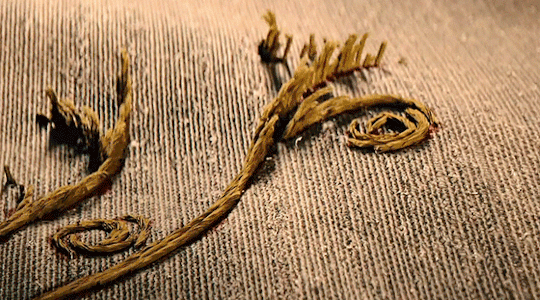
What makes the new opening credits so stunning beyond the Targaryen content is the method in which the captivating digital embroidered effect, coined “threadification,” is executed by design studio yU+co’s 3D division. Kudos for taking a medieval art and a modern art form and created a striking Medieval-esque masterpiece.
The success of which can only be credited to the commitment in understanding the threading process and how it could be transformed into a digital media.
I embroider myself and am self-taught. It was something I picked up more than a year ago, so this truly hit the spot for me.

Research pays off
yU+co’s design team studied the embroidery process from the Game of Thrones Tapestry and examined the Apocalypse Tapestry. It comes as no surprise that the GoT show runner would pitch The Bayeux Tapestry as inspiration for yU+co.
The Bayeux Tapestry is not a tapestry!, it is a 1,000 year old embroidery narrative depicting the series of events leading up to the Norman conquest of England in 1066, fought between William the Conqueror, Duke of Normandy and Harold, Earl of Wessex, later King of England.
Using this real world pictorial testimony of medieval war as a guide for the House of Dragons opening scenes only adds to the credibility and stellar execution.

Now a confession -
I was only this many years old when I found out about the existence of the Game of Thrones Tapestry😳. I thought I was a fan.. but apparently I was living under a rock because how did I miss this amazing piece of GoT content and art???!?

Game of Thrones Tapestry, Season 7, Episode 4 📸 Kal242382, CC BY-SA 4.0, via Wikimedia Commons
I believed the new opening credit sequence was completely original, as in no embroidery existed in the GoT world until HoD’s season two opening. Nevertheless, the opening credits are still amazing, still impressive, still educating people about the middle ages and how not dark they were.
Embroidery vs Tapestry
Magaret Wade Labarge in her article, "Stitches in Time: Medieval embroidery in its Social Setting," defines embroidery as:
"..the art of applying decoration by needle and thread to the surface of a piece of woven cloth, usually called the "ground." It is an optional decoration worked after the while weaving process, including the dyeing and finishing, has been completed."
When we look at the Bayeux Tapestry we clearly see the richly colored stitches embroidered on top of a cloth. The “design” is independent of the weave.
See what the Bayeux Museum has to say for itself-
So why does this misnomer matter? Because knowledge is power or maybe not, but you never know when this topic will come up at a dinner party or when you might bump into Chris Helsworth.

But really why should you care? First of all, it's important not to take things at face value, like The Bayeux Tapestry. And also this visual record is an extraordinary piece of history. Do you know how difficult it is to find textiles that survive, let alone in this condition?
The Norman Conquest was a big deal in European History. French speaking Normans ended up conquering England, Scotland, Wales, Ireland and even got to Southern Italy and Sicily! And, in doing so, they brought a wealth of new words, thousands of which are still used by us English speakers today.
Want more?
How the Medieval Tapestry in the New ‘House of the Dragon’ Opening Sequence Got Its Weave
Game of Thrones Tapestry
Frenchified English - thank you, Normans
16 notes
·
View notes
Text
Textile Time: The Coronation Mantle of Hungarian Monarchs

The Coronation Mantle. Copyright Hungarian National Museum, Budapest
Going through some old pictures, I found my picture of the incredible bronze relief of the Hungarian coronation mantle. Sculptor Rieger Tibor honored the 1000th anniversary of the coronation of King Stephen I with a recreation of the elaborately embroidered coronation mantle.

The Coronation Mantle, cast in bronze. On the exact spot where Francis I was coronated in 1792. Budapest, May 2022.
The original mantle wasn't designed for coronations. It was initially a vestment worn by a priest and made at the request of King Stephen I and his wife Gisela of Bavaria who donated it to the Church of the Virgin Mary in Székesfehérvár in 1031.
It wasn’t until the late 12th century, when due to its ornateness and connection to King Stephen I (later becoming St. Stephen in 1083) that the vestment transformed into a coronation mantle. Thereafter, it was worn by all future monarchs. The last time it was used was in 1916, by Charles IV.
A closer look at a copy of the mantle reveals iconography common at the time. We see more clearly that Christ is shown twice.

Unknown author, scanned by Szilas from A magyar Szent Korona by Tóth Endre, Szelényi Károly, Kossuth 2000, Budapest, Wikicommons, Public Domain
In the upper center, Christ treading on the beasts (a variant of Christ in Triumph), victorious over death, holding his feet on the necks of beasts- a dragon and a lion. This refers to Psalm 91:13, "Thou shalt tread upon the lion and adder: the young lion and the dragon shalt thou trample under feet." aka the Devil. On either side of him sit a crew of Old Testament prophets.

By Unknown author - The Coronation Mantle, close up of Christ. Wikicommons, Public Domain

Below the upper Christ, in the center is Christ in Mandorla Majesty on the throne flanked by Apostles.
Last but not least, patrons of the mantle, Gisela of Bavaria and King Stephen I get themselves featured below the Christs.

It is possible to make out the crowns as well as the objects in hand. Gisela holds a type of tower or building. King Stephen with an orb and spear of sorts.


By Unknown author - Wikicommons, Public Domain
According to the Textile Research Centre, embroiderers used several stitch types- stem stitch, chain stitch and feather stitch. The couching technique was used to create additional details.

Want to read more?
Textile Research Centre - Hungarian Coronation Mantle Rieger Tibor - The Coronation Mantle
#medieval embroidery#coronation mantle#budapest#medieval textiles#coronation#christ treading on the beasts
5 notes
·
View notes
Text
Iconography: JC Part 1
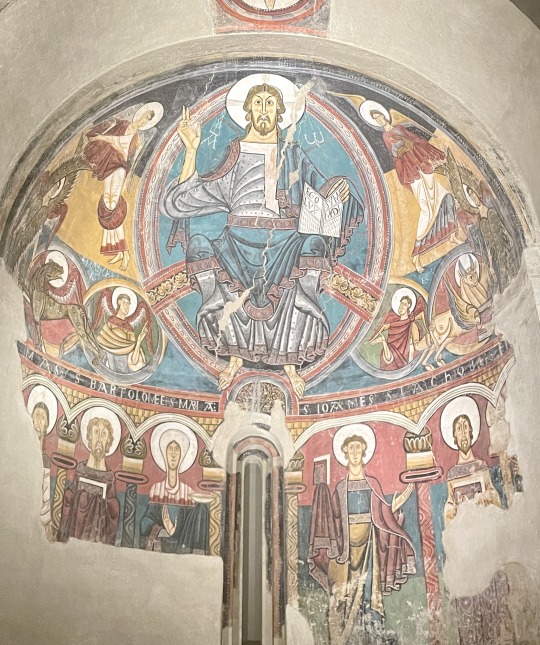
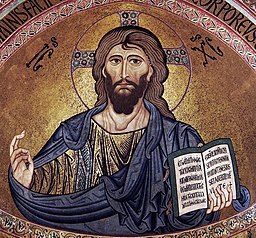


Christ in Majesty, fresco. Circa 1123. Master of Taüll. Apse of Sant Climent de Taüll Museu Nacional d'Art de Catalunya, Barcelona
Christ Pantocrator, mosaic. 1130. Cefalù Cathedral. Cefalù, Italy. 📷 Wikimedia Commons, Andreas Wahra, CC BY-SA 3.0
Christ in Judgment, tympanum, 1150. Abbey Ste Foy📷 Daniel Villafruela, CC BY-SA 3.0 via Wikimedia Commons
The Deesis mosaic, 1280. Hagia Sophia, IstanbuI, Turkey. Wikimedia Commons © JoJan, CC BY-SA 3.0
You've seen Him in frescos, mosaics, tympanum, paintings, illuminated manuscripts and more but do you know your Christ in Majesty from your Christ Pantocrator? The difference between Christ in Majesty and Christ in Judgment? What about the Christ Pantocrator and the Deesis?
Although sharing some similarities, the iconography of Christ differs between the Western Church and Eastern Orthodox Church.
The distinction comes from how both Churches interpreted the Heavenly throne described in The Book of Revelation and how those interpretations were then depicted in church architecture that developed in the East and West.
Early Christian art
Generally divided into two periods by scholars, early Christian art is bucketed into one of two camps: before and after either the Edict of Milan of 313 (whereby Christians were legally protected from persecution) or the First Council of Nicea in 325 (where Constantine I called for a meeting of all the Christian bishops to try to define Christian doctrine for all their followers around the Empire).
One of the major reasons for convening the council was major questions was around Christology. Specifically, what was the relationship between God the Son and God the Father. This concept is confusing and needed some consensus for sure (spoiler- was not figured in 325).

Regardless of the marker, once Christians were able to freely express themselves and their ideas about God in overt ways, a process began where the underground (literally in the catacombs), indirect symbols and ambiguous iconography of a persecuted people would evolve into mainstream icons for the all the world to see.
How would older symbols continue to be used? What new ones would develop? And, of course, where would Christians put them all?
Brief Christian History timeline
313 - Edict of Milan
325 - First Council of Nicea
324 - Constantine makes Byzantium the new capital of Roman Empire
330 - Byzantium becomes Constantinople
380 - Christianity becomes the state church of the Roman Empire
Late 5th century - collapse of the Western Roman Empire
Roman Empire 379-1453

Christian architecture
Christians would model their places of worship on the basilica, originally a large multi-functional public building in ancient Rome. The design of the original basilica was a rectangle shape with a longitudinal nave with an apse on one end (there could be more) and a roof with two levels, the higher roof in the middle to allow for a clerestory above.
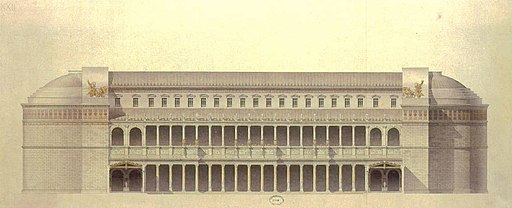
19th century reconstruction of the 2nd century AD Basilica Ulpia, part of the Trajan's Forum, Rome. Julien Guadet, prix de Rome, Public domain, via Wikimedia Commons
The basilica quickly became the template for a standardized architecture of Christian worship, the church. Specific features would Christianize for the church's needs, like the apse. In a civil basilica for example, the apse was the place where officials would congregate and where the Emperor would sit, in the Christian basilica it would become the place above the altar, where Jesus would be depicted. As time went on, the two Churches would use the space in ways that would effect the Christian art made inside.

Basilica of Sant'Apollinare in Classe near Ravenna, Italy, 6th century. Angela Rosaria, CC BY-SA 3.0, via Wikimedia Commons
Christian art
The various versions of Christ would gradually take form inside these churches, birthing the predecessors of the standardized iconography that would become the Christ in Majesty and the later Christ in Judgement and the Deesis and Christ the Pantocrator.
By the 4th, 5th and 6th centuries, the change was underway. It is as if artisans were thinking out loud on how to interpret the Old and New testaments, their images of a personified Jesus could be depicted in various ways - as a young, short haired, beardless, law giver, shepherd or even a warrior as well as bearded, long-haired and older, like the version standardized today.
Young, beardless Christ

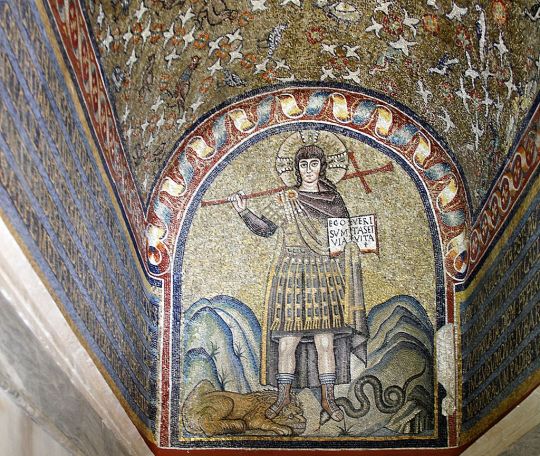
[Left] Christ the Lawgiver. Basilica of San Lorenzo, Milan, Italy. 4th century. Wikimedia Commons © Giovanni Dall'Orto
[Right] Christ treading the beasts. Chapel of Saint Andrew, Ravenna, Italy. 6th century. Wikicommons © José Luiz Bernardes Ribeiro
The mosaics above reflect important symbols and ideas of the time. In Christ the Lawgiver, Jesus is surrounded by his disciples. He is beardless, donning a golden halo. He is dressed in a white and gold toga and seated on a throne dais with his feet on a stool. His left hand holds the New Testament and raising his right hand (this right hand would have a number of meanings- from a gesture made to signal the right to speak, a gesture made by Emperors handing over a decree, to teaching gesture and finally becoming a gesture of blessing).
In Christ treading the beasts, Christ is alone, beardless, his head is surrounded by a golden four-armed cross halo. He is dressed in royal purple for battle, standing and stepping on the heads of the lion and the serpent. He is holding the Gospel with his left hand and grasping a large cross that rests on the shoulder, ready to take on any evil that may come his way.
In both cases, a young, beardless and haloed JC is taking on the appearance of a particular message the patron wants the artist to deliver to its audience.
Early Christian art was heavily influenced by Roman art and therefore the art that had influenced Rome, the art of Ancient Greece and thereby Greece's own influences - Egyptian, Mesopotamian and Persia art.
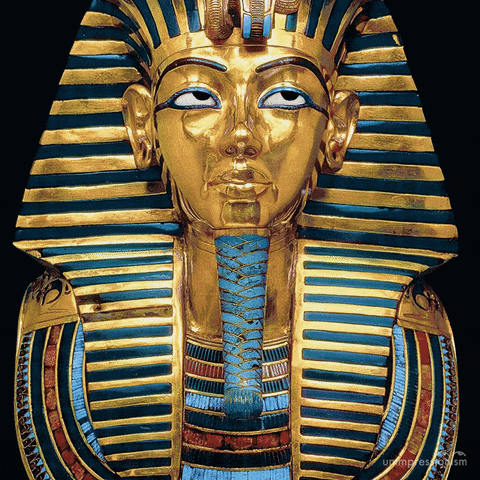
All cultures and religions take from and build upon the cultures and religions that came before them, adapting stories and visual language to suit their needs and the stories they want to tell.
If young strong Greco-Roman gods were portrayed as young and beardless, it would make sense for artists to show Christ in this way too. If deities in Ancient Egypt and Greco-Roman gods were depicted with halos/auras, Christ most certainty should too.
In the Lawgiver Christ, we see an emperor at the Forum with all other senators surrounding him. In Christ treading on beasts in Ravenna, we see a Christ in battle, triumphant against the hoards of pagan Germanic tribes to Ravenna's North or the defeat of Arianism within the Church itself.
Older, bearded Christ
The following image is said to be one of the earliest bearded Christ depictions which is now the prevailing, mainstream image we have come to know. Here Christ is fully bearded Jesus with long hair and a halo. This image emerged around 300, but it did not become established until the 6th century in the East and much later in the West.

Bust of a Bearded Christ, Catacombs of Commodilla, Rome, Italy. Late 4th Century. Wikimedia Commons, © Public Domain
Art historians point out several possible reasons why the now conventional images of Christ are bearded. Some like Paul Zanker surmise that this version is a reflection of Zeus, the King of Roman Gods and the look of the classical Roman philosophers. It would seem to me that most adult men had beards at the time. Certainly maybe, a 33 year old, Jesus probably would not have been clean shaven.
But how do we go from the above Jesus to Christ in Majesty, Christ in Judgment, Christ Pantocrator and the Deesis?
To be continued in a future post...

Sources
Depiction of Jesus
Early Christian art and architecture
Christ in Majesty
#christ in majesty#christian art#romanesque#christian iconography#art history#iconography#mosaic#architecture
0 notes
Text
Take me to Church: Grossmünster

Grossmünster, May 2023
Location: Zurich Country: Switzerland Denomination: Protestant Website: grossmuenster.ch
Grossmünster is a Romanesque styled church constructed from around 1100 to 1220 and built on the site of a Carolingian church that was said to be commissioned by Charlemagne.

The bronze doors of the main portal while not Medieval (done in 1935), caught my eye. People were streaming in and out so I lucky to get this shot! The majority of this door tells the story of the life of Hulrych Zwingli, the man who started the Swiss-German Reformation in Switzerland. But there are two that are not part of this story.

Let's explore. Bottom row, far left. Three figures holding their heads 😮 and bottom, far right - Charlemagne.
Turns out these three people are the three patron saints of Zurich, Felix, Regula and Exuperantius. They were beheaded in the 3rd century for converting to Christianity.

This is the seal stamp of the city seal of 1347 - Wikicommons
Other features of the cathedral include medieval pillars framing the entrance with modern grotesque decorated capitals.

Inside, the church was as Reformed as you could get with its scarce ornamentation- the legacy of Zwingli and his successor. I barely took any pictures.
But there were two things that caught my eye.
This modern carving of the tetramorph on either side of the main aisle before the altar. I spliced the pictures up to remove the aisle to get a seamless banner effect.

2. This medieval wall painting of the Virgin and Christ. Their faces likely removed during the Reformation (1520s)

Last shot before walking away to explore more were the two towers that are apparently one of Zurich's most famous landmarks. They were first erected between 1487 and 1492.
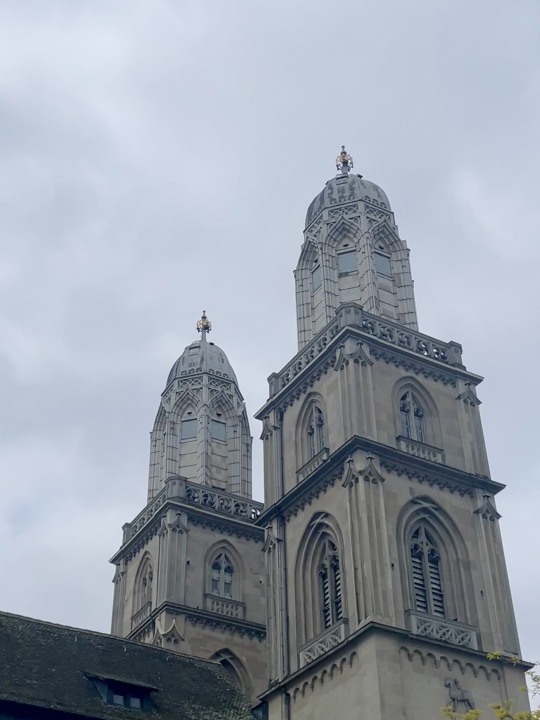
A fire in 1763 destroyed the original wooden steeples and these Gothic Revival ones replaced them in 1787.

1 note
·
View note
Text
Jesus Embroidery found in Russia🪡🧵

Found in a Medieval Russian burial ground, this embroidery fragment depicts the Deesis, a traditional iconic Byzantine and later Eastern Orthodox representation of Christ in Majesty or Christ Pantocrator.
The Deesis layout has Christ in the center of St John the Baptist to Christ's left and the Virgin Mary to his right. Christ is usually enthroned, holding a book in his left hand and raising the right hand in gesture of blessing. You can sort of make it out here. A praying St John can also be deduces but the other figure likely Mary, on the other side, has been lost. Archeologists believe this fabric was part of a headdress from sometime between the 13th and 15th century.
As someone who dabbles in various mediums of art - painting, illustration, leather work and even embroidery, I find it particularly fascinating to hear about and see even the smallest pieces of surviving textiles from the medieval period let alone even older eras.
0 notes
Text
Take me to Church: Basilica of Our Lady in Trastevere

Apse Mosaic by Pietro Cavallini, 1291 Basilica of Our Lady in Trastevere, January 2023
Location: Rome Country: Italy Denomination: Catholic Website: santamariaintrastevere.it
Mosaic fans, the 12th century artistry here was pretty unreal to see. Long on my list was to visit this church and with my limited time in Rome, it was the only one I got to see.
I knew of this Church in that it had gorgeous mosaics with gold but it's nothing like being in the space and experiencing it with all of your senses. I got as close as I could to the apse, past the classical columns that seemed so jarring to me.
As I stood and took it all in, there were a few things that stood out to me that were unusual, since most of the churches I've frequented are in the UK.
The apse here was obviously a mosaic and it's not just Christ enthroned at the center, it's the Virgin Mary too. And Christ has his arm around her. They both holds scrolls which is a nod to the Song of Songs
It's a representation of Christ and his bride, the Church/the Virgin Mary, check out my post: What’s up with that? Ecclesia and Synagoga for more background.
Above Christ is the Hand of God (Manus Dei) and a dark shadow radiating towards a cross. The alignment signifies the Trinity. The couple is surrounded by 7 figures to the left of Christ is Peter.
Below all this is a belt of Apostle lambs with #AgnusDei in the center. And below that are mosaics of Mary's life, The Nativity and The Adoration of the Magi scenes.
The Basilica of Our Lady in Trastevere is said to be one of the oldest churches in Rome, dating back to the 4th century and one of two churches (the other being the Basilica di Santa Maria Maggiore) that claim to be the first church dedicated to the Virgin Mary.

View with altar

Exterior Basilica of Our Lady in Trastevere, January 2023
Links for more:
Commentary on The Apse Mosaic at Santa Maris in Trastevere
0 notes
Text
What's up with that? Ecclesia and Synagoga

Close up of Ecclesia and Synagoga flanking the Fürstenportal or Princely Portal of Bamberg Cathedral, July 2022
My first trip to Germany, my first encounter with Ecclesia and Synagoga. I had never seen these statues before and once I learned their names it was clear which one was which. But why are these female figures personifying the Church and the Jewish Synagogue on a Church? That led me to this post.
Ecclesia and Synagoga, the ones that survive today anyway, are most often represented by young and attractive females. Ecclesia, the Church, stands strong and confident wearing a crown and carries a chalice and staff with a cross. Synagoga is blindfolded and/or looking down and carrying a broken spear and torah scrolls.
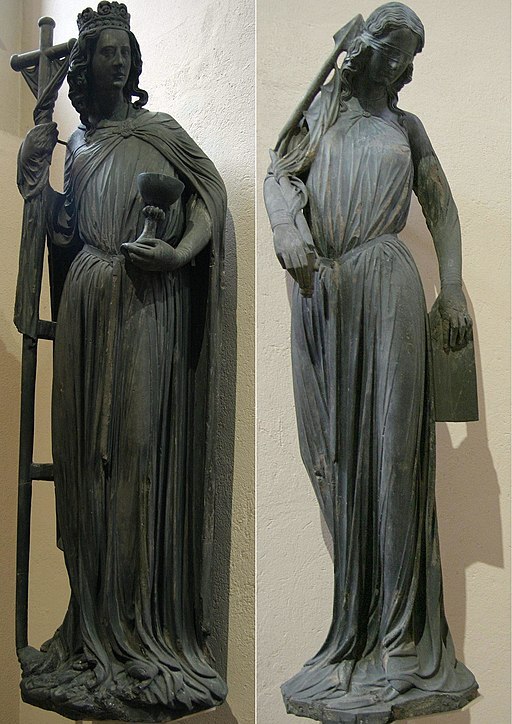
The original Ecclesia and Synagoga from the portal of Strasbourg Cathedral now in Musée de l'Œuvre Notre-Dame
My Ecclesia at Bamberg did not have the telltale signs of the staff with a cross or the chalice. But even with that, not knowing this symbolism, I wouldn't have put together the opposing woman as the Synagogue. It seemed to me to just depict someone blind to the faith of Christianity, not everything must be about Jews..right?
According to her book on the subject The Jew, the Cathedral and the Medieval City: Synagoga and Ecclesia in the Thirteenth Century, Nina Rowe explains that Ecclesia and Synagoga are generally found on the cathedrals of larger cities in northern Europe that had significant Jewish communities, especially in Germany(!) It was meant to remind Jews of their place (as if they needed the reminder) in a Christian dominated society. She notes most portal figures are from the 13th century.
So when did the Ecclesia and Synagoga depictions start?
Wikipedia says around 830, in a Crucifixion from the Drogo Sacramentary. Pic is in the public domain.

How and Why?
Ecclesia's characteristics on Christ's right hand side are already defined, the chalice collecting his blood but the Synagoga is an old gray haired man looking up. Synagoga stayed in this form, while rare, until 12th century when she became blindfolded with a broken lance. At this later time, the emphasis of Synagoga being defeated by the Church is the main objective of its symbolism and becomes a woman.
Rowe notes this timing coincides with the increasing Jewish populations in Germany and other place in Europe. There were increasing interactions between Christian and Jewish scholars and notably their different interpretations of the Hebrew Bible. The figures became a tool to reinforce the power dynamic of the Church.
Before Ecclesia met Synagoga

For centuries before her "coupling with Synagoga," Ecclesia had her own things going on. She had long been represented as the Bride of Christ taking the form of a queen. The Book of Revelation mentions "the Bride" many times and the Gospel of John talks of Christ as a "bridegroom."
Judith Glatzer Weshler expounds in A Change in the Iconography of the Song of Songs in 12th and 13th century Latin Bible, that Ecclesia imagery was sometimes conflated with the Virgin Mary, where Mary herself was depicted as the Church.
This timing is in line with the shift Nina Rowe talks about, when the portal figures appear on cathedrals. In general the 13th century was a particularly shitty time for Jews. But that's a whole other post.
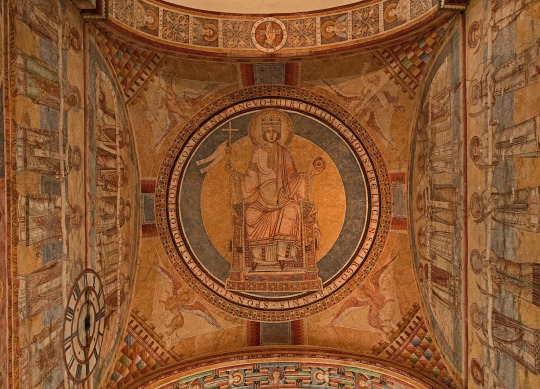
Ecclesia enthroned, Prüfening Abbey, Bavaria, 12th century
There is a precedence in the Old Testament for the symbolism between God and people, via the Song of Songs, a poem that celebrates sexual love between a man and a woman.
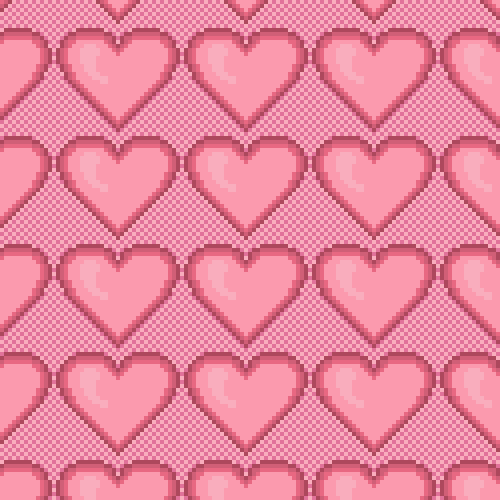
Jewish tradition reads it as an allegory of the relationship between God and Israel, the Jewish people.
Christianity interprets it as an allegory of Christ and his bride, the Church.
In her incredible book, "Mother of God, A History of the Virgin Mary," Miri Rubin writes about a Christian theologian, Origen (c 185- c 254) who advised early Christian followers to market and substantiate their new religion to potential Jewish converts. He thought by focusing on the Jewish Bible, the one they already knew, they could position "Christianity truth" as the revealing of new, necessary, inescapable reinterpretation of the text they thought they knew.
Origen engrossed himself particularly in the Jewish commentary of the Songs of Songs where he found messaging to fit a Christian paradigm, and replaced the Church as the bride of Christ.
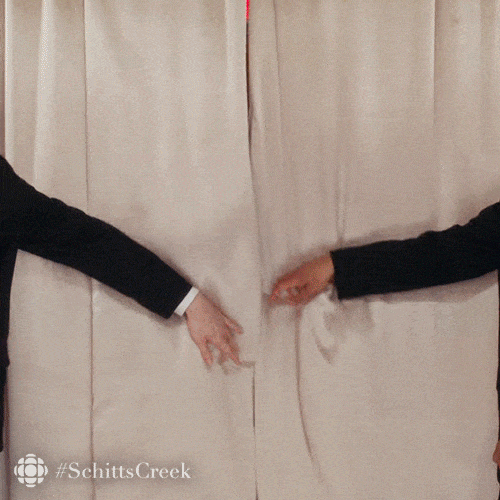
Links for more:
Ecclesia and Synagoga
Wikipedia - Song of Songs
#church art#cathedrals#christianity#medieval art#christians and jews#christian symbolism#medieval cathedrals
0 notes
Text
Tympana Tyme: Bamberg Cathedral
My first trip to Germany, my first German Cathedral. It was under renovation and it was closed for visitors the day I was there, so I could only shoot the exterior. Luckily, there were two tympanum waiting for me.

Last Judgment of the Fürstenportal or Princely Portal. Bamberg Cathedral, July 2022
This is the most tame Last Judgement scene that I’ve seen either with my own eyes or in research. Most are MUCH more gruesome, detailed and interesting. The damned on the viewer’s right all have strange expressions and there’s a single demon, the last figure on the right, who is pulling them away.

Gnadenpforte or The Marian or Grace Gate, Bamberg Cathedral, July 2022
The veneration of Mary by St. Peter and St. George on either side.
In this wider shot below, we see two statues of women on either side of the portal. They are Ecclesia and Synagoga. More on Ecclesia and Synagoga in a forthcoming post.
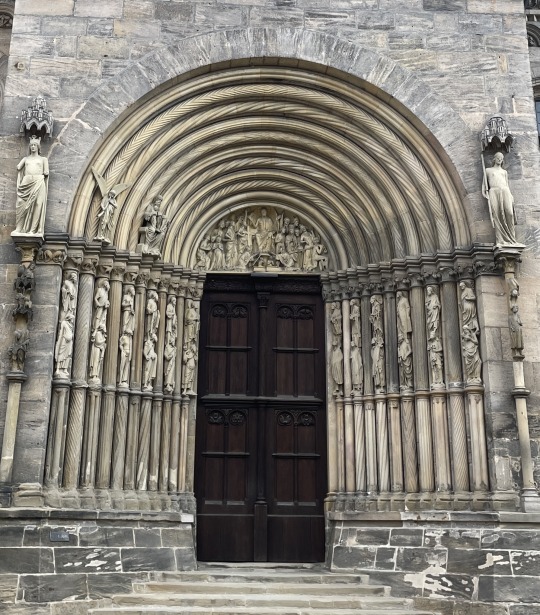
Location: Bamberg Country: Germany Denomination: Roman Catholic Website: https://bamberger-dom.de
0 notes
Text
Tympana Tyme: St Mary de Crypt Church

St Mary de Crypt Church, November 2021
Location: Gloucester Country: England Denomination: Church of England Website: https://discoverdecrypt.org.uk
What total luck I had to be walking back to the train and look up to see this Agnus Dei, inside a tympanum, no less 😍. According to Wikipedia, this 12th century church has many romanesque features and this sculpture carved over the west door is one of the most well-preserved.
Check out this previous post on the Lamb of God depicted in rather horrific way.
0 notes
Text
Take me to Church: Gloucester Cathedral

Gloucester Cathedral, November 2021
Location: Gloucester Country: England Denomination: Church of England Website: gloucestercathedral.org.uk
Is there a cathedral out there has better vaults than Gloucester? I’m not sure.
Let’s be honest, I came here for the Cloister’s fan vault, not because of Harry Potter but because it is one of the earliest known fan vaults. So that’s where we’ll head first.

It takes a person who loves something, like history or art or architecture or nature or anything at all, a minute to relish in the feeling of being somewhere meaningful. Don’t get me wrong, that meaning isn’t the same for everyone and it could be anything but the one thing is common, is that the person feels alive.
Seeing this hallway made me feel alive. And it’s all because in the 14th century, in England, local craftsmen and their master mason for whatever reason decided to do something differently. They moved away from a style of beautiful geometric functionality to create (maybe the first) dendritic stone forest, so all encompassing, you feel you might grow roots yourself.


I left the Cloister to and headed to the Choir for it magnificent lierne vault.
If the Cloister fan vault felt like trees and earth, here you feel the sky and the stars surround your very being with an extricate constellation comprised of 400 bosses- a celestial orchestra of heavenly angels.

As you move closer to The Great East Window or Crécy Window, and the altar, you notice the perpendicular style in full effect. The window tracery extends over the walls, acting like the circuits of a power grid spreading outward. The spires of the altar rise up to connect to the grid fueling the electricity already circulating the place.
And then you get to the Great East Window which at the time of its installation in the 1350s, was the largest window in the world - the size of a tennis court. It is made of nine tiers of rectilinear panel tracery.


Heading back to the choir, built 1337–1350, and the first in Perpendicular style in a major church, I sought as many misericords with creatures on them as I could find out of the forty six , but the area was roped off due to covid restrictions, so I definitely missed quite a few.
Per Wikipedia, the cathedral has forty-six 14th-century misericords and twelve 19th-century.



A visit here wouldn’t be complete without scoping out the tomb of Edward II. The detail of its cinquefoil arches and pinnacled canopy is quite impressive as is the early English alabaster effigy.


1 note
·
View note
Text
Medieval Enamel Pins
A selection of animals and monsters from the Book of Revelation (series 1) 'cause who doesn't want an Apocalyptic pin??!?




Worlds collide
As medieval history fan and lifelong creator, I finally came up with the idea to merge my two most consistent interests into one single project after taking Animals and Monsters in Medieval Art at the End of the World with Professor Monica Walker. (I highly recommend you check this course out to see it’s available again at Oxford Continuing Ed, if it's your jam too.)
No creative pursuit has given me as much joy as this one (and I dabbled in designing and producing my own shoe line via successful kickstarter before my second son was born)

Apocalyptic Collection
I chose to do the Red Dragon, the Beast, the Apocalyptic Lamb and a Locust from a variety of manuscripts. The Dragon and the Beast however are from the same Beatus manuscript, featured together in a single page representation of the Adoration of the Beast.
Why these particular animals and monsters?
Well, to be honest it was REALLY hard to choose. I scoured all the Illuminated Manuscripts we covered in the aforementioned course and my first inkling was to just do all kinds of locusts.
The depictions of locusts are so incredible and amazingly varied throughout the Beatus manuscripts and in the Anglo-Norman ones, but then I thought a variety of different animals would speak to more people. Maybe one day, with enough interest, I can do a whole series of infernal locusts).
But I ended up picking the ones I loved the most, and thought others might love too.

I'm currently selling these pins by special request only. Please email me at: [email protected] if interested.
Pin Details
Red Dragon - The Great Dragon was cast out of Heaven and now can be yours Beatus of Facundus. Ms Vit. 14.2, f°191v Enamel pin 1.5" w x 2" h Black dyed plating Double closure
The Beast - The dragon gave him his power, his authority can now be yours Beatus of Facundus. Ms Vit. 14.2, f°191v. Enamel pin ~1.1" w x 2" h Black dyed plating Single closure
Infernal Locust - Fifth Trumpet! Brace yourself for the Locust Plague MS M.644 fol. 142v. Spain, perhaps in Tábara, ca. 940-945 Enamel pin 2" w x ~1.6” h Black dyed plating Single closure
Apocalyptic Lamb - Adoration of the Lamb. Enough said. MS. Douce 180 fol. 18v. 13th century. Enamel pin ~1.6" w x 1.75" h Black dyed plating Single closure

0 notes
Text
Apocalypse Now! TV edition: 30 Coins has it all - monsters, priests, Judas’ betrayal of Christ

I reallyyyy enjoyed the Catholic mystery horror series from HBO Spain- priests, demons, exorcism, Judas’ betrayal of Jesus, the 30 coins that Judas received from the Romans to betray Jesus Christ - all wrapped up in an X-files-esque 8 part series (which is coming back for a second season!!)
Every episode has some paranormal event which is connected to the larger story of Good vs Evil and a version of the Apocalypse brought about by securing the 30 coins. At times the series had moments reminiscent of a stereotypical Spanish telenovela, but I didn’t mind, it’s a Spanish show!
The show did a great job at creating new monsters to keep you up at night. Here they are in order of most scary to me:

-Baby Spider Monster (episode 1 - Cobwebs) - huge spider with a baby face stuck in it. For me being the most suspenseful of all episodes and setting the tone, this mysterious baby born from a cow is shrouded in mystery, you don’t know what is going on at all and then you see this insane mash up of a spider and baby coming to kill Elena.
-The Devil Behemoth (episode 8- Sacrifice) - Angel shows himself in true form? All white.. and then this enormous demon appears with no face but instead a huge claw where one would be. Its torso is made up of thousands of souls writhing in pain. Is it Angel in his true form? Not sure, but not so scary because it didn’t have a face, very scary because it literally looks likes its stomach is actually Hell where souls are burning and fueling the monster’s existence.
-Priest Spider Monster (episode 5 - The Double) - huge spider made up of the remains of a murdered priest with his torso and other bits sticking out of a gross big bulbous stomach. This spider monster is bigger and faster than Baby Spider Monster.
-Necromancy Spider Lady (episode 8- Sacrifice) - the witch sprouts legs as a toned down regular sized spider monster hybird. Not scary at all, but another monster and she goes down pretty quickly.
Why all the arachnid imagery and not the usual demon with horns and hoofs trope?

Arachnophobia is one of the most common phobias (I scoured the Internet and it’s almost in all the top 10 phobias) Ok, so spiders, they are creepy, they crawl everywhere, they have lots of legs, they come out of nowhere, they don’t look like us or most animals we come into contact with. I can see why people don’t like them and I can definitely see how enormous spiders would be scary but I’m still not convinced this was the scariest they could get.
Last thought, there’s also TONS of great symbolism especially in that last episode, Sacrifice - SO. MANY. LAMBS. which makes sense in terms of its use in the Apocalypse.
0 notes
Text
Monstrous lambs
Jesus is depicted as a lamb and not in the form of a man, in early Christian art. In many early Apocalypses, Christ is represented as the apocalyptic lamb with seven eyes and seven horns and can be varying degrees of horrifying.
My favorite apocalyptic lamb is this one from the Bodleian Library Apocalypse

Oxford, Bodleian Library MS. Douce 180, fol. 18v
And now for the close up:

This God of Lamb has all the iconography going on - seven horns, seven eyes, he has a banner of triumph hoisted on a large cross, his wounded side is spewing blood which pours directly into a chalice. The only thing missing is the halo but I guess that would been over the top.
Erik Wade on Twitter has a great thread about The Lamb of God sounding sweet but in actuality it’s terrifying.
1 note
·
View note
Text
Afterlife, I love a good Afterparty: Hellscapes, Sculpted edition - Abbey of St. Foy in Conques & Lincoln Cathedral
I can’t get enough of Hell. Particularly my latest love is the Romanesque Last Judgement tympanum (early 12th century) at the Abbey of St. Foy in Conques. It came up as an example of apocalyptic art in my Animals & Monsters at the End of the World in Medieval Art course.
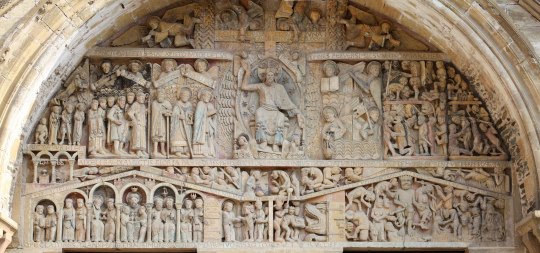
📸 by Daniel Villafruela Abbaye Ste Foy à Conques (06) - Tympan du Porche. (2021, February 19). Wikimedia Commons, the free media repository. Retrieved 17:51, February 21, 2021
It never ceases to amaze me that people hundreds of years ago made these intricate scenes of the Last Judgement and how completely intriguing I find them. No matter how many Last Judgements I have seen, it seems Hell and its horror has been given much more thought as it displays the most action and enthusiasm compared to the depictions of Heaven. No matter how many saved people are standing around with all the angels, saints, prophets, no one looks ecstatic to be there with God, let alone happy. It’s mood is reserved and overall imho- kinda boring.
I was reminded of another Romanesque Hellscape scene from the 12th century, a frieze on the West front of the Lincoln Cathedral that previously held my attention for some time.
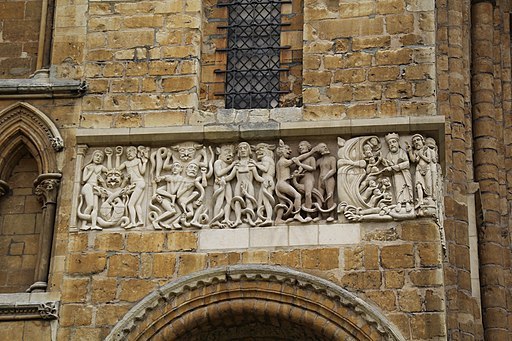
📸 Richard Nevell (WMUK) Carving on exterior of Lincoln Cathedral (1). (2020, September 28). Wikimedia Commons, the free media repository. Retrieved 18:16, February 21, 2021. This is a replica of a 12th century original.
Location, Location, Location
We cannot forget that these carvings are deliberate in their placement and their messaging. They are purposely located on the greatest billboard in town - the West Front of the abbey/church/cathedral.
There is no way the laymen and laywomen entering the church could miss these carvings and no way the gruesome sight of Hell and eternal suffering wouldn’t leave them traumatized (let alone any Jews that might walk by). Sermons may do one thing, but harrowing scenes of Hell, that imagery, that my friends is what will scare the shit out of you and might convince you to follow the teachings of Jesus.

It’s true, I’m just fixating on the Hell part. But in reality, we’re talking about Heaven and Hell, as I’ve said, the iconography around the Kingdom of Heaven is just soooo under welcoming and everyone just stands around, there’s no great feast or party depicted where people and saints and God enjoy (after)life or do anything interesting at all.
Iconography of Hell
I thought it might be fun to compare and contrast Conques and Lincoln’s Hells:
the demons
the torment and overall Hellscape feel and, last but not least,
Hellmouths
So first, where did this notion of demons and devils come from and how should they look?

Demon iconography 101
In doing my research for my short paper “Monstrous Motifs in Lincoln Cathedral Architecture,” I was surprised to learn that depictions of evil were not personified as demons in Christian art before the 9th century.
When they did surface in the *Carolingian manuscript, the Stuttgart Psalter, in around 830 AD, the personification of evil as demons was complete.
They were depicted as naked hybrid human-goat enities. They had some or all of the following characteristics: horns, claws, hair, hooves, tails and elongated ears. These physical characteristics were influenced by the demonization of the nature gods like Pan, known to be half-man, half-goat and the negative connotation of goats, which exist in Christian dogma around the Judgement, such as in The Parable of the Sheep and Goats (Matthew 25:31-46), goats over time came symbolize the Devil and his lesser demons.

Stuttgart Psalter cod. lat. 23, fol. 29v.
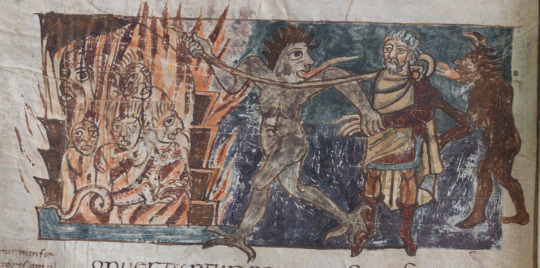
Stuttgart Psalter cod. lat. 23, fol. 10v
But these notions of beastly creatures don’t end here! The notions of beastly creatures may find their origin in the 2nd century Greek text, the Physiologus, which contained information on animal behaviors, their nature, habits and allegorical interpretation. The 2nd century didactic Christian Greek text, Physiologus, which contained information on animal behaviors, their nature, habits and allegorical interpretation.

According to Belita Goad, in her 2004 Masters thesis, Bestiary Influences upon Medieval Demonography, Physiologus is considered the predecessor of the medieval illuminated manuscript tradition of Bestiaries, which limned demons in the minds of medievals for the first time, producing,“some of the most enduring iconography of Christianity.”
Bestiary tradition and animal lore were well known in the minds of medieval people, their illustrations and stories resonated with an illiterate public. Their didactic and moralizing nature were especially useful in sermons as their stories conveyed the nature of certain animals to be virtuous or Christ-like while others were known to have been more maligned or demonic. These malevolent connotations informed demonic imagery - in merging different parts of malevolent animals, a recipe for the monstrous was concocted.
In the 6th century mosaic, The Sheep and the Goats, in Basilica di Sant'Apollinare in Classe, in Ravenna, Italy, Christ himself is depicted (not as a shepherd but in royal purple Roman robes), showing the separation of the sheep from the goats as a way to explain what Judgment will be like. With his right hand he signifies that the sheep are the Chosen and the goats can go to Hell! Is this the tamest of all Judgments??

The Sheep and The Goats Metropolitan Museum of Art , CC0, via Wikimedia Commons
Hellscapes
Both sites feature carvings of large eared (or horned?) humanish goat/ape hybrid demons demoning- doing their thing, poking, punishing, tormenting and torturing the damned souls in the same sort of vision of Hell. They also include demonized serpents aiding in the torment.
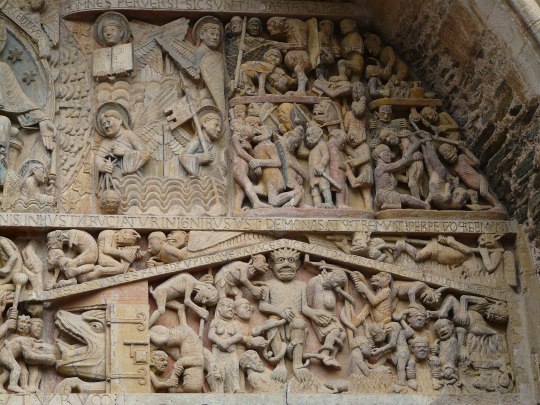
📸Abbey of Saint Foy in Conques - detail of Hell (2021, February 10). Wikimedia Commons, the free media repository. Retrieved 18:09, February 21, 2021

📸Lincoln Cathedral, Torments of Hell. Irid Escent, CC BY-SA 2.0, via Wikimedia Commons
At St. Foy, I believe one snake eminates from the Devil himself, whereas at Lincoln, snakes and a wyvern (the scene on the far left) assist demons in their torture, wrapping around the damned like ribbons of wrath, just a little extra pain and suffering beyond what the demons are doing. If we compare the two, St. Foy’s Hell looks a bit more hellish compared to Lincoln’s Hell.
St. Foy’s demons, equipped with instruments to prod or hang the damned appear more active, contorting in all kinds of positions to inflict maximum torture. Also, I ❤️ the Devil. Look at him (below) in Devil in Majesty - peering out to the audience, just like JC does. Nice touch.

Abbey of Saint Foy. Close up of Majesty positions in Hell and Heaven (original pictures have been cropped). 📸PMRMaeyaert, CC BY-SA 3.0, via Wikimedia Commons
Overall, Lincoln’s Hell appears much tamer and organized, but it isn’t a Last Judgment - its a selection of specific sins where each person/people are tortured based on their specific sin with a specific demon carrying out the act, plus snakes (because they are so evil).

Lincoln Cathedral - detail of restored Romanesque frieze (cropped for just scenes of sin) 📸 John Lord from Edinburgh, Scotland, CC BY 2.0
Hellmouths or jaws of Hell
This should be a future post unto itself!

Abbey of Saint Foy. Weighing of the souls, Gates of heaven and the Mouth of Hell (detail), Last Judgment tympanum, Church of Sainte‐Foy, France, Conques, c. 1050–1130, photo: Nick Thompson (CC BY-NC-SA 2.0)
The Hellmouth at Conques is a part of the composition of The Weighing of the Souls motif. Archangel Michael is bent over mirroring the hunched over, kneeling and grinning demon. The demon has very pronounced nose and long ears. As one would expect the demon has stuck out his index finger to tip the odds in Hell’s favor. How devilish!

Just below we see the entrances to Heaven and Hell. A demon at the rather tame Hellmouth that looks very Leviatan-ish /Whale of “Jonah and the Whale”is waiting to devour people head first. The demon is charge of pushing the damned face first into the Hellmouth has very exaggerated facial features and hair. It is looking backward at the line of souls waiting in front of St Peter (I presume) at the Gates of Heaven. This demon seems to have caught the eye of the fourth person in line to entering those pearly gates. What is the reasoning for this? Can Demons influence a soul that has already been judged saved but not yet in Heaven itself? You would expect that demon to be focusing on the using that bulbous ended rod in its hands to push the already bent over damned into the mouth of Hell.

The Hellmouth of The Harrowing of Hell scene also know as Anastasis (resurrection in Greek) is our comparable Hellmouth at Lincoln.

📸Irid Escent, CC BY-SA 2.0, via Wikimedia Commons
So this takes place in the period of time between the Crucifixion of Jesus and his resurrection. Another Jonah reference! Three days, three nights in the belly of the whale.. now son of man will copy him by going to the heart of the earth.... You know, nothing is original.
So here we have JC descending into Hell and releasing its captives. The Hellmouth is too tame for the opening of HELL, not even a single tooth portrayed. Even its eyes are absent of pupils or anything that would denote expression. I love the massive Jesus who is nonchalantly stepping on the torso of the Devil or a devil and reaching out like a politician does when walking through a crowd of supporters. The dead are like fish shooting upstream some to grab ahold to his hands, some praying fervently. All the dead have the same sort of expressionless zombie look about them - does not look like anyone was tormented at all....
Having looked at these 12th century Hell depictions, one in France and one in England, there are many similarities but also many differences. Mainly in the gruesomeness or restraint shown in the overall Hellscape. St. Foy’s tympanum is much more elaborate as it displays a Last Judgment pictorial program. Lincoln’s frieze focuses on a few key scenes. I should note there is a Last Judgement portal at Lincoln (very subdued in its content) and was not known to me during the time of this post.
Some questions I am left with
Are French depictions of Hell overall more gruesome than those of the English? Who’s are the most Hellish?
What’s up with the Carolingians and demons?
A dream of mine is to go on a Last Judgement tympanum pilgrimage and expand on this topic further. If you have a favorite, drop it in the comments!
2 notes
·
View notes